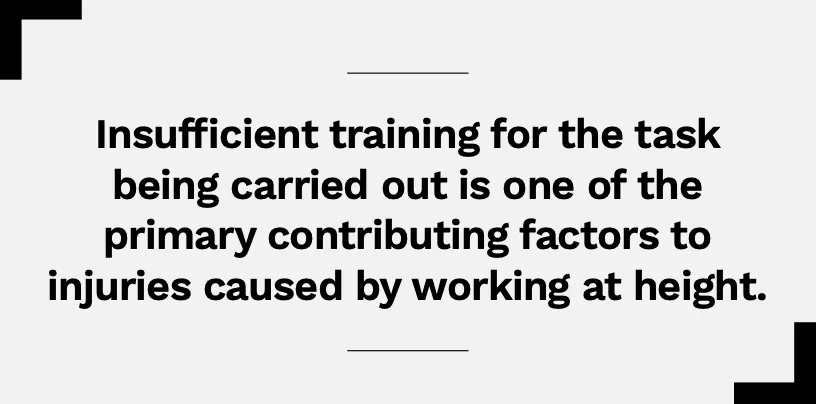Working at Height
Te Mahi ki ngā Tiketike

Who needs to read this?
All workers who undertake tasks at height should read and understand the section on ‘minimum responsibilities of working at height’.
Roles that have specific responsibilities, or influence, over setting up and managing work at height should read the section on ‘planning and guidance considerations and responsibilities’ – this includes Producers, Directors, Line Producers, Production Managers, Art Directors, Construction Managers, Heads of Department, Assistant Directors and Health and Safety oOfficers.
What is Working at Height?
Work at height means working in a place where a person could be injured if they fell from one level to another.
When considering working at height you must also consider and manage the risk/s associated with falling objects, if it is reasonably likely that the object would fall on and injure a person.
There is no threshold for working at height; if someone or something could fall from one level to another and injure an individual then that is working at height.
Work at height does not include slips, trips and falls at the same level.
What specific working at height risks are there on production sets?
- Camera platforms (mobile and static)
- Rigging, including cranes (mobile powered elevating equipment)
- Scaffolding
- Ladders
- Elevated working platforms
- Rostra
- Studio lighting grids, gantries and catwalks
These risks are further outlined in individual chapters.
see also:
WorkSafeNZ (Ministry of Business, Innovation & Employment) Best practice guidelines for working at height in New Zealand. April 2012
Regulations 24 and 25 of the Health and Safety at Work (General Risk and Workplace Management) Regulations 2016
Minimum Responsibilities for Working at Height
Everyone who works at height on a screen production should read and understand this section, including Grips, Lighting crew, Camera crew, Special effects and Art Department crew.
If you are responsible for, or have influence over, an activity or task where there is work at height, you should read and understand the following section on ‘Planning and Guidance Considerations and Responsibilities’.
All workers should:
- understand the risks associated with working at height, and the possibility of both people and objects falling and injuring someone;
- follow all procedures and controls put in place to keep themselves and others safe when working at height;
- use personal protective equipment when required; and
- advise their supervisor or the health and safety officer if they observe unsafe working at height practices.
Planning and Guidance Considerations & Responsibilities
Too many falls from height occur because of a failure to plan or organise work properly.
Everyone who is responsible for, or has influence over, an activity or task where there is work at height should read and understand this section, as well as the minimum responsibilities for everybody.
This includes the Production Company, Producers, Art Directors, Construction Managers, Line Producers, Heads of Department, Assistant Directors and Health and Safety Officers.
Identifying the Risk of Working at Height
Everyone who is responsible for an activity or task in relation to the production should consider the potential risks associated with working at height; this is where someone or something could fall from one level to another causing harm to an individual.
Ways of identifying such risks include:
- physical inspections – walk around the production set, you could use a checklist to help you;
- looking at work practices and required tasks;
- consulting with cast and crew; and
- reviewing previous safety event information.
see also:
WorkSafeNZ. Working at Height Toolkit.
Fact sheet 1. Planning a safe approach to working at height. June 2015.
How do we Assess the Risk of Working at Height?
Just like any health and safety risk you must assess it – thinking about:
- the likelihood of the potential harm; and
- the consequence – how bad the harm would be.
* See the Risk Assessment Section: This health and safety risk assessment process will help you undertake a risk assessment.
What are other risks that can Impact on working at Heights?
The potential risks associated with working at height can be compounded by other hazards. The following list is not exhaustive and a full risk assessment, by a competent person, should always be undertaken prior to work at height.
- Overhead power supplies – electrical shock.
- Corroded or fragile upper level surfaces.
- Poorly constructed, secured and or positioned scaffolding.
- Weather elements – e.g. wind or rain.
- Slippery or unstable surfaces.
- Working alone.
Managing the risk of working at height
How do I control the Risks of Falls from Height?
First, you must consider whether you can eliminate the risk, if this is not reasonably practicable then you must minimise that risk – this is called the hierarchy of controls.
* See Risk Assessment Section: This health and safety risk assessment process will further help you understand how to use the hierarchy of controls.
see also:
WorkSafeNZ. Working at Height Toolkit. Fact sheet 1. Planning a safe approach to working at height. June 2015.
WorkSafeNZ (Ministry of Business, Innovation & Employment) Best practice guidelines for working at height in New Zealand. April 2012
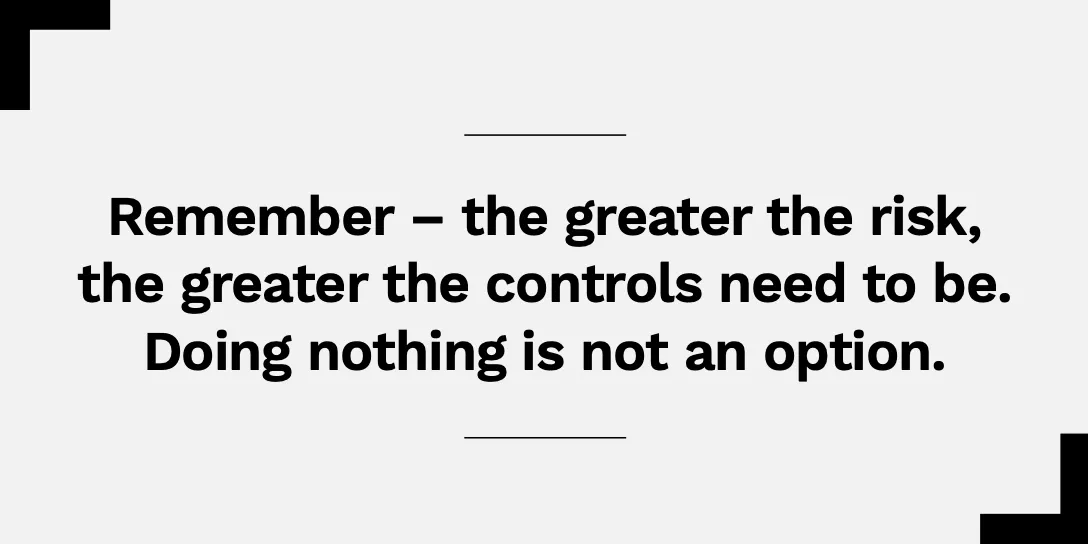
Elimination is the most effective control method.
You could eliminate the risk of working at height by:
- removing the requirement for the task, if practicable under the circumstances;
- using long handled tools from ground level;
- building structures at ground level and lifting them into position when finished; or
- ensuring equipment that may require maintenance is placed close to the ground
Elimination can be best achieved at the design and construction planning stage.
If complete elimination of the risk is not reasonably practicable, you must consider ways to minimise the risk starting by looking at how you could prevent a fall from occurring.
You could minimise the risk by preventing the fall through the use of:
- edge protection;
- a guard railed work platform (such as scaffolding or elevated work platforms);
- barriers to restrict access; or
- a total restraint system to prevent people getting close to the height hazard.
If you cannot prevent a fall then you must look at ways to minimise the harm that could occur from a fall.
Minimising the distance and impact of a fall must only be considered after you’ve exhausted all elimination controls and minimisation controls that would have prevented the fall in the first place. You can minimise the distance and impact of a fall using:
- a fall arrest (harness) or work positioning system; or
- safety nets or soft-landing systems.
What's the difference between Group Controls and Personal Controls?
As well as the hierarchy of controls, you need to think about controls that will protect multiple people. These are group controls, and the best methods to use as they that don’t require active judgement by individuals to keep themselves safe – for example scaffolding or a safety net.
Personal controls only protect the individual using the control and rely on the user using them correctly to ensure their safety.
See also
WorkSafeNZ (Ministry of Business, Innovation & Employment) Best practice guidelines for working at height in New Zealand. April 2012
How do I select the right Equipment?
When deciding what control to use, as well as considering the hierarchy of controls and group versus personal controls, you should also think about other factors that may affect the success of your controls. See the table below as a guide.
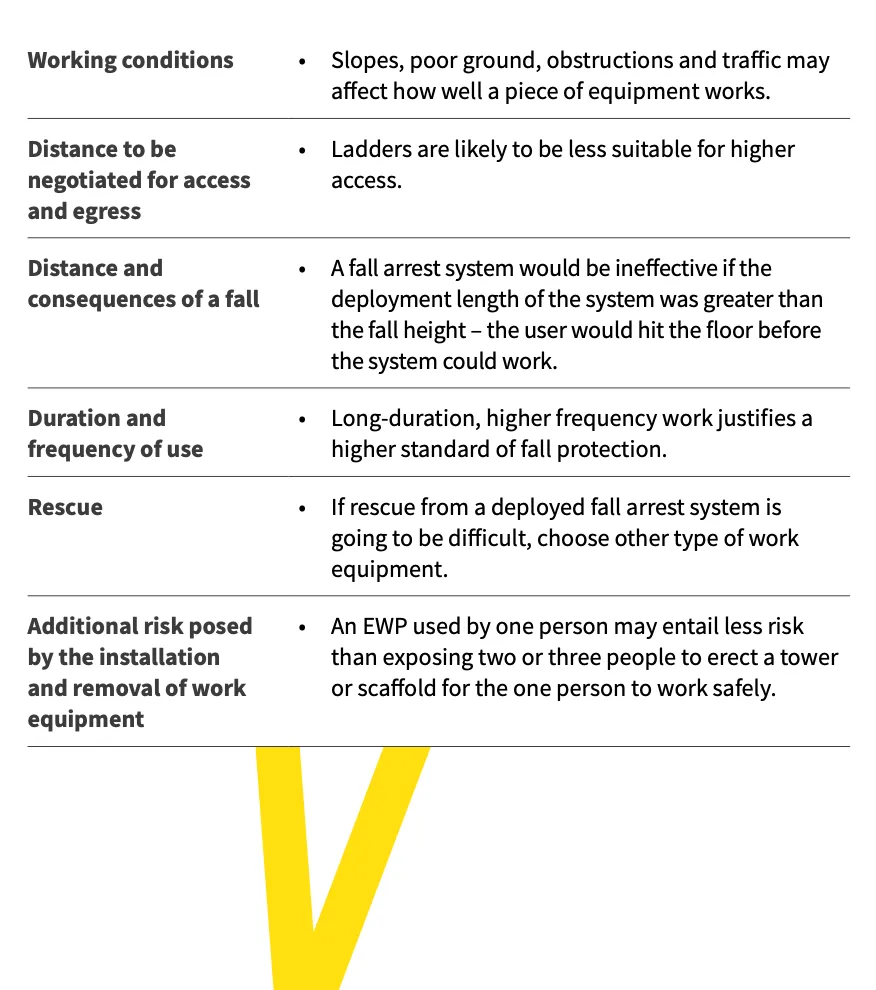
What type of controls can you use?
There are many different types of controls that you could use for eliminating or minimising the risks associated with working at height.
The primary controls used within the screen industry are detailed further risk-specific chapters.
Depending on the set circumstances, you may also wish to consider the below controls, you can find out more information about these control methods in WorkSafe guidance.
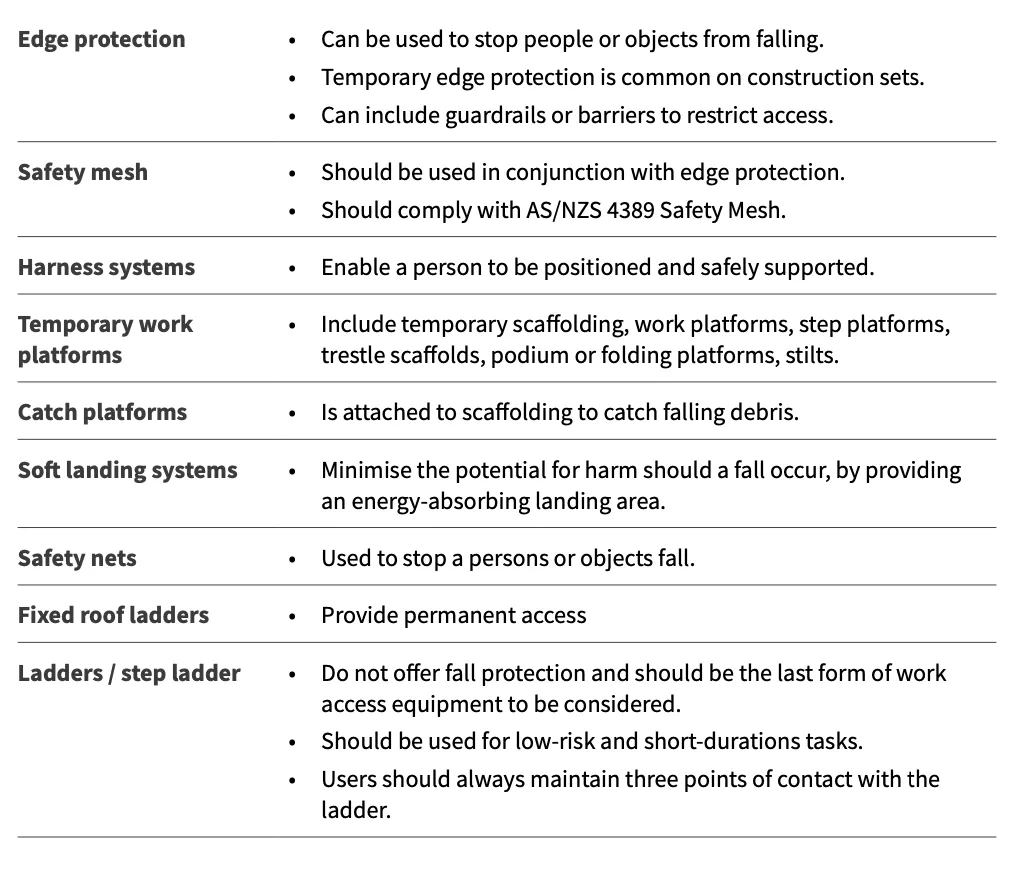
Rescue plan
All working at height activities, where it has been identified that a fall would require a rescue mission or any potential harm, would require an immediate medical response should have a rescue plan.
Factors to be considered while developing a rescue plan include:
- the location of the work area in terms of the accessibility to appropriate medical facilities;
- ensuring there is an adequately trained person on ground level able to initiate the rescue plan in the event of a fall;
- communications;
- the type of rescue equipment required and its proximity to the work area; and
- first aid capabilities.
Adequate information and training on the rescue plan should be provided to those working at height, and any potential rescuers.
The rescue plan should be formally tested, before work commences, to ensure effectiveness.
Under no circumstances is a person to be used in suspended casualty emergency drills. The drills should be simulated using a mannequin or other suitable method.
Click HERE to download the RESCUE PLAN TEMPLATE
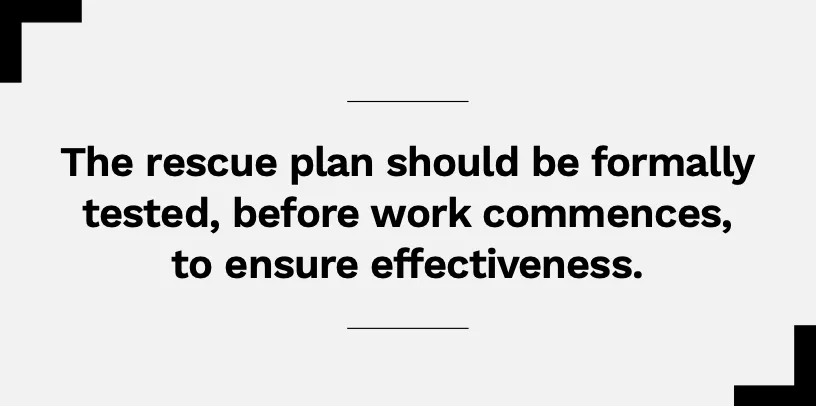
Responsibilities
Funders
Funders should:
- be assured, through the provision of the production’s health and safety plan, that the funding provided is adequate to provide controls for working at height tasks.
Production Company
In pre-production, production companies (likely to have primary responsibility over health and safety on the production) should:
- consider the potential risks associated with working at height when planning and allocating tasks;
- ensure the potential risks associated with working at height are appropriately managed, either eliminating or minimising them; and
- engage competent persons to oversee and undertake all working at height tasks associated with the production.
Producer / Production Manager / Art Director / Construction Manager / Heads of Department
As these roles have oversight across these elements of production, they should (during pre-production and the production):
- ensure to engage competent people to implement working at height tasks;
- consider the potential risks associated with working at height when planning and allocating tasks;
- manage the potential risks associated with working at height, either eliminating or minimising them; and
- engage competent persons to oversee and undertake all working at height tasks associated with the production.
Assistant Director/s
The Assistant Director/s should ensure the potential risks associated with working at height are discussed with all cast and crew during health and safety inductions and / or as required if circumstances on the set change.
Health and Safety Officer
The Health and Safety Officer should ensure potential risks associated with working at height are discussed with all cast and crew during health and safety inductions and / or as required if circumstances on the set change.
Training
Insufficient training for the task being carried out is one of the primary contributing factors to injuries caused by working at height.
As part of all PCBUs primary duty of care to provide and maintain a safe and health work environment, they must ensure workers have had the necessary training to allow them to undertake their work safely.
Anyone who has direct oversight of a worker undertaking a working at height task should ensure they are adequately trained and competent in their work. This will often be the Head of Department.
Things to think about include, does the worker have:
- basic training to competently undertake the task safely; and
- basic training / experience teaching them how to ensure the risk control is effective, including use of personal protective equipment?
Or do they require:
- a specific certificate or qualification to operate the equipment or undertake the task; or
- supervision by a competent person, if they are new or don’t have the required level of training?
WorkSafe’s guidance outlines the levels of compliance and competency required for specific working at height tasks and control.
References
Click HERE to download the QUICK GUIDE checklist for Working at Height
Click HERE to view WorkSafe's overview on Working at Height
Read: A GUIDE FOR SAFE WORKING PRACTICES IN THE NEW ZEALAND THEATRE & ENTERTAINMENT INDUSTRY
